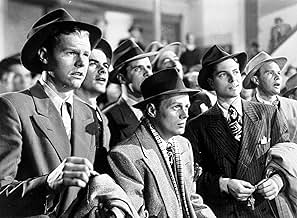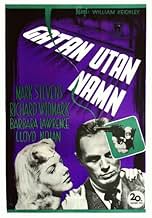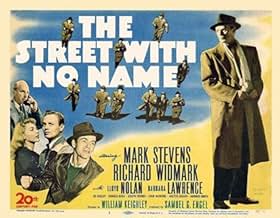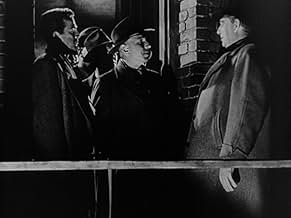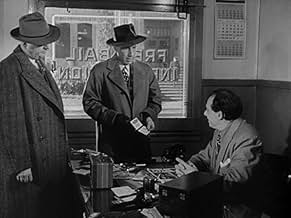VALUTAZIONE IMDb
7,0/10
3497
LA TUA VALUTAZIONE
Aggiungi una trama nella tua linguaA covert FBI agent infiltrates a ruthless gangster mob, but his life is at risk from a mysterious informant who funnels inside information to the hoodlums.A covert FBI agent infiltrates a ruthless gangster mob, but his life is at risk from a mysterious informant who funnels inside information to the hoodlums.A covert FBI agent infiltrates a ruthless gangster mob, but his life is at risk from a mysterious informant who funnels inside information to the hoodlums.
- Regia
- Sceneggiatura
- Star
- Premi
- 2 vittorie e 2 candidature totali
Larry Anzalone
- Sparring Partner
- (non citato nei titoli originali)
George Barrows
- Bouncer at Gym
- (non citato nei titoli originali)
Joan Blair
- Valentine Laval
- (non citato nei titoli originali)
James J. Casino
- Cornerman
- (non citato nei titoli originali)
Lane Chandler
- Policeman at Arcade
- (non citato nei titoli originali)
Dick Cherney
- Man at Gym
- (non citato nei titoli originali)
Noble 'Kid' Chissell
- Prisoner
- (non citato nei titoli originali)
Edmund Cobb
- Desk Sergeant
- (non citato nei titoli originali)
Recensioni in evidenza
At first, the docu-drama approach feels like kind of a safety net that prevents the viewer from losing himself completely in this striking noir universe, but the intricacies of the police work were interesting to watch unfold and this is still a strong film. Particularly memorable are the taut, virtually noiseless chase scenes that take place in suitably dark, nightmarish settings, like the one where crook Widmark sniffs out undercover cop Stevens at the hideout. I also liked the colorful low life lingo such as when one of the thugs tells Stevens to "pick yourself a boom-boom" as they suit up for their big score.
Great to see Richard Widmark doing what he does best - playing villains, of course. Few actors could match Widmark when it came to that staple of screen heavies: losing their temper. This guy slaps people's faces with a karate-like precision that's remarkable. And just the way he tells some flunkie henchman he doesn't want around to "blow" is pure heaven. In a role like this, he owns the screen; he's like a well dressed rat always scavenging for his next meal.
I was reading a Cornell Woolrich story about a year ago and one of the characters used a Mark Stevens' picture as an alibi for where they had been at a certain time. Never having heard of Stevens I assumed it was just a made up movie star name and movie title ("I Wonder Who's Kissing Her Now".) Imagine my surprise when shortly thereafter I looked up his name and found out that there certainly was such an actor, a borderline leading man who apparently enjoyed some level of stardom during a 30 or so film career. Judging by his appearance here, he's a good, functional actor, though he has the sort of face it's easy to forget. Which is probably why he was selected for this part, as he isn't asked to carry the film (he's off screen for about half the running time) and as an undercover agent he's naturally required to blend in with his new environment. He does that quite well.
Great to see Richard Widmark doing what he does best - playing villains, of course. Few actors could match Widmark when it came to that staple of screen heavies: losing their temper. This guy slaps people's faces with a karate-like precision that's remarkable. And just the way he tells some flunkie henchman he doesn't want around to "blow" is pure heaven. In a role like this, he owns the screen; he's like a well dressed rat always scavenging for his next meal.
I was reading a Cornell Woolrich story about a year ago and one of the characters used a Mark Stevens' picture as an alibi for where they had been at a certain time. Never having heard of Stevens I assumed it was just a made up movie star name and movie title ("I Wonder Who's Kissing Her Now".) Imagine my surprise when shortly thereafter I looked up his name and found out that there certainly was such an actor, a borderline leading man who apparently enjoyed some level of stardom during a 30 or so film career. Judging by his appearance here, he's a good, functional actor, though he has the sort of face it's easy to forget. Which is probably why he was selected for this part, as he isn't asked to carry the film (he's off screen for about half the running time) and as an undercover agent he's naturally required to blend in with his new environment. He does that quite well.
Inspector Briggs : Lloyd Nolan enlists in the state organization to rookie FBI agent Gene Cordell : Mark Stevens, as he is assigned to a dangerous mission : to infiltrate himself into a nasty band led by an evil mobster named Styles : Richard Widmark . Things go awry when a corrupt mole at the police station is delivering information to the gangsters. The FBI Goes Undercover To Nab A Cold-Hearted Killer in This All-Star Crime Thriller With A Unique Storytelling Twist!. Counter Attack! A New Era Of Violence In The Making... A New Kind Of Gangster On The Loose! Here's The Real-Life Drama Of The FBI Counter-Attack Where Law And Order Break Down!
Classy Noir with thrills, supenseful , tension, plot twists and shady characters . Including a semi-documentary style at times , in fact the film's opening prologue states: ''The motion picture you are about to see was adapted from the files of the Federal Bureau of Investigation. Wherever possible, it was photographed in the original locale and played by the actual F. B. I. Personnel involved¨. Stars Mark Stevens providing a good acting as the new FBI agent, along with Loyd Nolan as a tough chief who leads the investigations against the ominous criminal organization. But the best acting goes to the great Richard Widmark, giving an extraordinary show as a ruthless gangster with sadistic tendency by killing , hitting enemies and mistreating his girlfriend, the beautiful Barbara Lawrence. The Street with No Name(1948) is one of three consecutive Richard Widmark Noir films where he performed an evil gangster along with Kiss Of Death and Road House. They're well acccompanied by a remaining and effective support cast , such as : John McIntire, Ed Begley, Howard Smith, Donald Buka, Lane Chandler , Howard Smith , and Joseph Pevney , subsequently a notorious filmmaker .
It contains an atmospheric cinematography in black and white with plenty of lights and shades by Joseph MacDonald , who along with Nicolas Musuruca , John Alton and John Seitz are the best cameramen that worked in the Noir Film genre . The picture was competently directed by William Keighley. This filmmaker was expert on Noir as proved in Each dawn I die, Ladies they talk about, G Men, Bullets and ballots and The Street with no name . Rating : 7/10 . Better than average.
Classy Noir with thrills, supenseful , tension, plot twists and shady characters . Including a semi-documentary style at times , in fact the film's opening prologue states: ''The motion picture you are about to see was adapted from the files of the Federal Bureau of Investigation. Wherever possible, it was photographed in the original locale and played by the actual F. B. I. Personnel involved¨. Stars Mark Stevens providing a good acting as the new FBI agent, along with Loyd Nolan as a tough chief who leads the investigations against the ominous criminal organization. But the best acting goes to the great Richard Widmark, giving an extraordinary show as a ruthless gangster with sadistic tendency by killing , hitting enemies and mistreating his girlfriend, the beautiful Barbara Lawrence. The Street with No Name(1948) is one of three consecutive Richard Widmark Noir films where he performed an evil gangster along with Kiss Of Death and Road House. They're well acccompanied by a remaining and effective support cast , such as : John McIntire, Ed Begley, Howard Smith, Donald Buka, Lane Chandler , Howard Smith , and Joseph Pevney , subsequently a notorious filmmaker .
It contains an atmospheric cinematography in black and white with plenty of lights and shades by Joseph MacDonald , who along with Nicolas Musuruca , John Alton and John Seitz are the best cameramen that worked in the Noir Film genre . The picture was competently directed by William Keighley. This filmmaker was expert on Noir as proved in Each dawn I die, Ladies they talk about, G Men, Bullets and ballots and The Street with no name . Rating : 7/10 . Better than average.
Impressive documentary style noir with a commanding performance by Richard Widmark. Apparently utilising real cops, FBI and internal and external locations, this is a most involving and believable little thriller. The opening is a bit dated with it's 'raise the flag' and breast beating stance in the name of J Edgar Hoover, but once this gets going it is really intoxicating. The night streets of 'skid row' are dripping with shadows as one character after another slips in and out of doorways to pool house or strip joints. There is a major sequence in a boxing gym with a couple of fights in progress and training going on around whilst a bunch of hoods take and place bets on this and that. Good tale, very well told and beautifully photographed.
This underrated noir, efficiently handled in all departments, has rather unjustly been overshadowed by its higher-profile color remake – Samuel Fuller’s HOUSE OF BAMBOO (1955), which I’d watched before but will re-acquaint myself with now thanks to the original (scheduled as part of my ongoing Richard Widmark tribute).
The film (whose title is allegorical) deals with F.B.I. rookie Mark Stevens infiltrating a criminal gang headed by Widmark; the Bureau gave Fox (who produced it) their full co-operation: the studio, in fact, had already made THE HOUSE ON 92ND STREET (1945) in a similar vein and, though THE STREET WITH NO NAME is marked by that earlier title’s innovative semi-documentary style, it actually ties in more with the gangster pictures of the 1930s. Incidentally, director Keighley had been responsible for a number of these over at Warners – including BULLETS OR BALLOTS (1936), which I may well check out presently on the strength of my positive response to this one!; Besides, the hero’s undercover activity and the suspense inherent in such a situation anticipates Raoul Walsh’s WHITE HEAT (1949) – while its scenario, also involving the concurrent presence of a ‘rat’ operating within the Bureau itself, would be replicated nearly 60 years later in Martin Scorsese’s THE DEPARTED (2006)!
At first glance, Stevens looks like an unlikely tough guy but, in retrospect, he acquits himself surprisingly well; Widmark – in his second film – has graduated from sadistic thug to unscrupulous gang boss (memorably introduced, with his face half-hidden behind a handkerchief during a night-club ‘job’, spitting a line at the orchestra conductor: “O.K., Stokowski…dry up!”). The film is also blessed with a terrific supporting cast (including Lloyd Nolan, John McIntire and Ed Begley – all of whom play F.B.I. operatives – Donald Buka being especially noteworthy among the criminals as Widmark’s taciturn but ruthless right-hand man, and only one prominent female figure in Barbara Lawrence as the typically-abused gangster’s moll).
As expected, Joe MacDonald’s shadowy lighting emerges to be an indispensable asset here – rendered even more effective (and realistic) by locations carefully-chosen to fit the desired mood of every sequence. A remarkable outburst of violence at the film’s climax (set inside a warehouse) is equivalent, then, to the icing on the cake.
The film (whose title is allegorical) deals with F.B.I. rookie Mark Stevens infiltrating a criminal gang headed by Widmark; the Bureau gave Fox (who produced it) their full co-operation: the studio, in fact, had already made THE HOUSE ON 92ND STREET (1945) in a similar vein and, though THE STREET WITH NO NAME is marked by that earlier title’s innovative semi-documentary style, it actually ties in more with the gangster pictures of the 1930s. Incidentally, director Keighley had been responsible for a number of these over at Warners – including BULLETS OR BALLOTS (1936), which I may well check out presently on the strength of my positive response to this one!; Besides, the hero’s undercover activity and the suspense inherent in such a situation anticipates Raoul Walsh’s WHITE HEAT (1949) – while its scenario, also involving the concurrent presence of a ‘rat’ operating within the Bureau itself, would be replicated nearly 60 years later in Martin Scorsese’s THE DEPARTED (2006)!
At first glance, Stevens looks like an unlikely tough guy but, in retrospect, he acquits himself surprisingly well; Widmark – in his second film – has graduated from sadistic thug to unscrupulous gang boss (memorably introduced, with his face half-hidden behind a handkerchief during a night-club ‘job’, spitting a line at the orchestra conductor: “O.K., Stokowski…dry up!”). The film is also blessed with a terrific supporting cast (including Lloyd Nolan, John McIntire and Ed Begley – all of whom play F.B.I. operatives – Donald Buka being especially noteworthy among the criminals as Widmark’s taciturn but ruthless right-hand man, and only one prominent female figure in Barbara Lawrence as the typically-abused gangster’s moll).
As expected, Joe MacDonald’s shadowy lighting emerges to be an indispensable asset here – rendered even more effective (and realistic) by locations carefully-chosen to fit the desired mood of every sequence. A remarkable outburst of violence at the film’s climax (set inside a warehouse) is equivalent, then, to the icing on the cake.
J. Edgar Hoover, it now seems, was a mediocre crimefighter but a master orchestrator of his own publicity (and only secondarily that of the FBI). The Street With No Name stands as one of the better films dedicated to kissing his assiduously cultivated legend. Most directors assigned these tasks in the noir cycle wrote off such idolatry as a cost of doing business, clearing it away quickly so as to get on with their moviemaking; William Keighley follows this sensible agenda.
FBI agent Mark Stevens goes undercover to infiltrate the mob in that cesspool of crime, Center City, USA. In the boxing ring, he attracts the attention, slightly open to inference, of boss Richard Widmark, a dapper ("I like my boys to look sharp") cutthroat with a morbid fear of drafts and sneezes. With the aid of confederate John McIntyre, Stevens reports the gang's plans back to the FBI. Alas, a high-placed informant in the police department reports the FBI's plans back to Widmark.
So the movie boils down to the agent-in-peril story. Keighley tells it cleanly and briskly, eschewing the complexities (both visual and moral) of Anthony Mann's T-Men, released just a few months earlier. It's strongest in the feel for Center City's raffish tenderloin, with its fleabag hotels, pool halls and walk-up gyms. Stevens, McIntyre and Lloyd Nolan (as Stevens' superior) give workmanlike jobs with the rather staid roles scriptwriter Harry Kleiner supplies. His few-frills approach reins in Widmark, too, who's always better when he's unfettered and shooting over the top.
The Street With No Name suffers a bit from staying so resolutely all-guy; thus Barbara Lawrence suffers, too, in an underwritten and inconsequential part as Widmark's abused moll. A little more cool yin might have balanced out all that hot, hard yang.
NOTE: In 1955, Samuel Fuller remade -- and rethought -- this movie, using the same screenwriter and cinematographer (Joe MacDonald, now working in color) as House of Bamboo, set in postwar Tokyo.
FBI agent Mark Stevens goes undercover to infiltrate the mob in that cesspool of crime, Center City, USA. In the boxing ring, he attracts the attention, slightly open to inference, of boss Richard Widmark, a dapper ("I like my boys to look sharp") cutthroat with a morbid fear of drafts and sneezes. With the aid of confederate John McIntyre, Stevens reports the gang's plans back to the FBI. Alas, a high-placed informant in the police department reports the FBI's plans back to Widmark.
So the movie boils down to the agent-in-peril story. Keighley tells it cleanly and briskly, eschewing the complexities (both visual and moral) of Anthony Mann's T-Men, released just a few months earlier. It's strongest in the feel for Center City's raffish tenderloin, with its fleabag hotels, pool halls and walk-up gyms. Stevens, McIntyre and Lloyd Nolan (as Stevens' superior) give workmanlike jobs with the rather staid roles scriptwriter Harry Kleiner supplies. His few-frills approach reins in Widmark, too, who's always better when he's unfettered and shooting over the top.
The Street With No Name suffers a bit from staying so resolutely all-guy; thus Barbara Lawrence suffers, too, in an underwritten and inconsequential part as Widmark's abused moll. A little more cool yin might have balanced out all that hot, hard yang.
NOTE: In 1955, Samuel Fuller remade -- and rethought -- this movie, using the same screenwriter and cinematographer (Joe MacDonald, now working in color) as House of Bamboo, set in postwar Tokyo.
Lo sapevi?
- QuizThe chase inside the ferry terminal was filmed in the San Pedro Municipal Ferry Terminal in Los Angeles. The building now houses the Los Angeles Maritime Museum.
- BlooperThe wall behind Ed Begley during the Danker interrogation changes from brightly lit to sharply defined shadows of prison bars and back to brightly lit again.
- Citazioni
Alec Stiles: I haven't seen you around lately.
Gene Cordell: [as George Manly] I've been away.
Alec Stiles: Is that right?
Gene Cordell: Weekend in the country.
Alec Stiles: Courtesy of the city?
Gene Cordell: Something like that.
- ConnessioniFeatured in Los Angeles Plays Itself (2003)
- Colonne sonoreBeg Your Pardon
(uncredited)
Written by Francis Craig and Beasley Smith
Performed by Marion Marshall during the opening stick-up
I più visti
Accedi per valutare e creare un elenco di titoli salvati per ottenere consigli personalizzati
- How long is The Street with No Name?Powered by Alexa
Dettagli
- Data di uscita
- Paese di origine
- Siti ufficiali
- Lingua
- Celebre anche come
- The Street with No Name
- Luoghi delle riprese
- Municipal Ferry, San Pedro, California, Stati Uniti(As Center City: George Manly walks down street and is tailed to ferry.)
- Azienda produttrice
- Vedi altri crediti dell’azienda su IMDbPro
- Tempo di esecuzione1 ora 31 minuti
- Colore
- Proporzioni
- 1.33 : 1
Contribuisci a questa pagina
Suggerisci una modifica o aggiungi i contenuti mancanti




